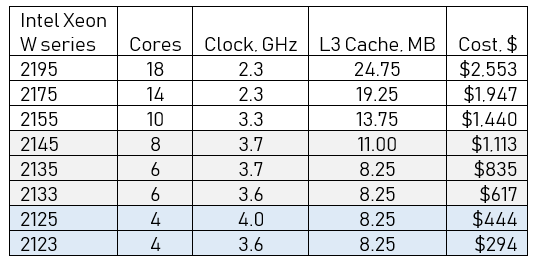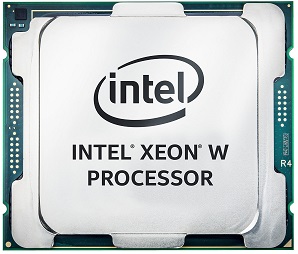Intel has built a special processor just for workstations.
Intel’s latest generation of Xeon processors are specifically designed for workstations, and the company has cleverly designated them the W series.
Workstations are a growing market segment and have been for quite some time. They run 24-7, are extremely reliable, and have features and specifications you can’t find in a PC. Therefore, workstations can command high price points because of the high expectations users have for them. Our research shows the market size for workstations is approximately 5.3 million units, about 2% of the total PC market, and brings in over $10 billion dollars a year, almost 2.5% of the PC market total, which indicates the average selling price (ASP) is higher than the ASP of a PC.
Given the demands on a workstation, it behooves Intel to recognize that and offer a special processor. And with the W series, Intel has done just that. Intel offers eight W class Xeon processors which cover the midrange to the ultra-high-end of the workstation market. All of them are based on the 14-nm Skylake architecture and have up to 18 cores that can run 36 threads, support four channels of DDR4 2666 ECC memory (for up to 256 GB of RAM), have 48 PCIe lanes which can be used not just for add-in boards (AIBs) but also for M.2 SSDs. The cores, clocks, cache, and cost are the main variable in the series.

As the table indicates, when the core count goes up, the clock frequency comes down. That is to balance the power consumption of the processor and subsequently the temperature of the device.
Everything about a workstation is bigger than a PC, except for their physical size. A workstation runs heavy-duty mission-critical applications, and often for days at a time. As such it has to be extremely well designed to manage the thermals, noise, and overall reliability.
Storage plus. As mentioned, in the workstation world, everything is bigger. In the case of workstations that is absolutely true. Being able to locally store and work a giant model is paramount to productivity.
When it comes to storage, if you can get large, super-fast local storage, your productivity will improve, almost automatically. Intel address this need with their Optane SSD. Intel Optane memory is a new memory tier, a faster storage repository for most often used data and metadata, that resides between system memory (RAM) and the main storage subsystem. It offers high quality of service (QoS), and high endurance, and overcomes the data access bottlenecks. It accelerates applications with fast caching and fast storage to increase the scale of a project or model and reduce transaction costs for latency sensitive workloads.
More of everything. Users want large memory spaces to hold their data and models. They also want big storage that is fast. SSDs and blended storage devices like Intel’s Optane SSDs are must-have items for workstation users. And the memory has to be extremely reliable. Error-correcting code memory (ECC memory) is a must, and one OEM, Dell, has expanded on that with their Reliable Memory Technology (RMT) Pro, which is designed to work with ECC memory. RMT helps protect machine workstation from potential crashes by mapping out bad memory locations after the system reboots.
More of everything. Users want large memory spaces to hold their data and models. They also want big storage that is fast. SSDs and blended storage devices like Intel’s Optane SSDs are must-have items for workstation users. And the memory has to be extremely reliable. Error-correcting code memory (ECC memory) is a must, and one OEM, Dell, has expanded on that with their Reliable Memory Technology (RMT) Pro, which is designed to work with ECC memory. RMT helps protect machine workstation from potential crashes by mapping out bad memory locations after the system reboots.
Applications
Workstations are used in high-demand applications in engineering, design, and manufacturing. In addition to the traditional workstation applications, there is a new workload—AI training. Say AI-training and the first thing people think of is a GPU. But, at an Intel AI meeting, Facebook shared some interesting data showing that it uses Xeon-based servers for all inference work and select training jobs, and GPUs for training Convolutional Neural Networks (CNNs) for image processing and Recurrent Neural Networks (RNN) for speech and language translation. Those same processors can be found in most workstations. And although it doesn’t create any new sales opportunity, most enterprises have surplus CPU capacity in their servers and workstations, which can be used at night. Intel says it has eased the software burden to use those existing resources for many machine learning workloads.
Visualization. Big visualizations systems also known as software as a service—SaaS leans heavily on W series workstations. Workstation-based interactive and photorealistic rendering via Software Defined Visualization (SDV) is with the open source Intel Rendering Framework and is supplanting GPUs in many modern HPC supercomputing centers, asserted Intel in a guest post in Inside HPC, October 2018.
The ability to run and visualize with SDVs solutions, without requiring specialized hardware for an interactive response, is a major benefit for visualization clusters.
CAD. Computer-aided design used in architectural, automotive and mechanical design has always been a mainstay of workstations. CAD represents the largest base of people using visualization tools and workstation for their work. The top line is that we estimate revenues of $8.2 billion for 3D CAD in 2017², and we believe there are over 1 million 3D CAD users.
Media and animation software. The media and animation (M&A) market is a specialized market, critical to game development, special effects, visualization, and the emerging VR and AR markets. Almost everyone working in modeling and animation has a need to run big workloads and render their work. M&A is relatively small in comparison to the entire Media & Entertainment software tools market, which we estimate as a $6 billion market today. Of that, M&A is about $250 million³.
Conclusion
The professional applications that run on and require a workstation are very specialized. Therefore, to support them one needs a specialized system, a workstation. But a workstation isn’t just a big PC, it has super reliable components, large fast memory capacity, is power efficient, and generally remarkably quiet. Workstations aren’t for everybody and because of that, and the special effort that goes into making them, they are typically more expensive than a PC. However, if a mission-critical system goes down, the relatively small difference in price between a rock-solid workstation and PC becomes trivial. In fact, in survey after survey, price is never the first, second, or even third most important factor in selection.
¹Artificial Intelligence Conference, April 15 – 18, New York, NY, https://conferences.oreilly.com/artificial-intelligence/ai-ny
2https://www.jonpeddie.com/press-releases/the-overall-cg-market-grows-to-147-billion-by-2021
³https://www.jonpeddie.com/press-releases/the-overall-cg-market-grows-to-147-billion-by-2021






